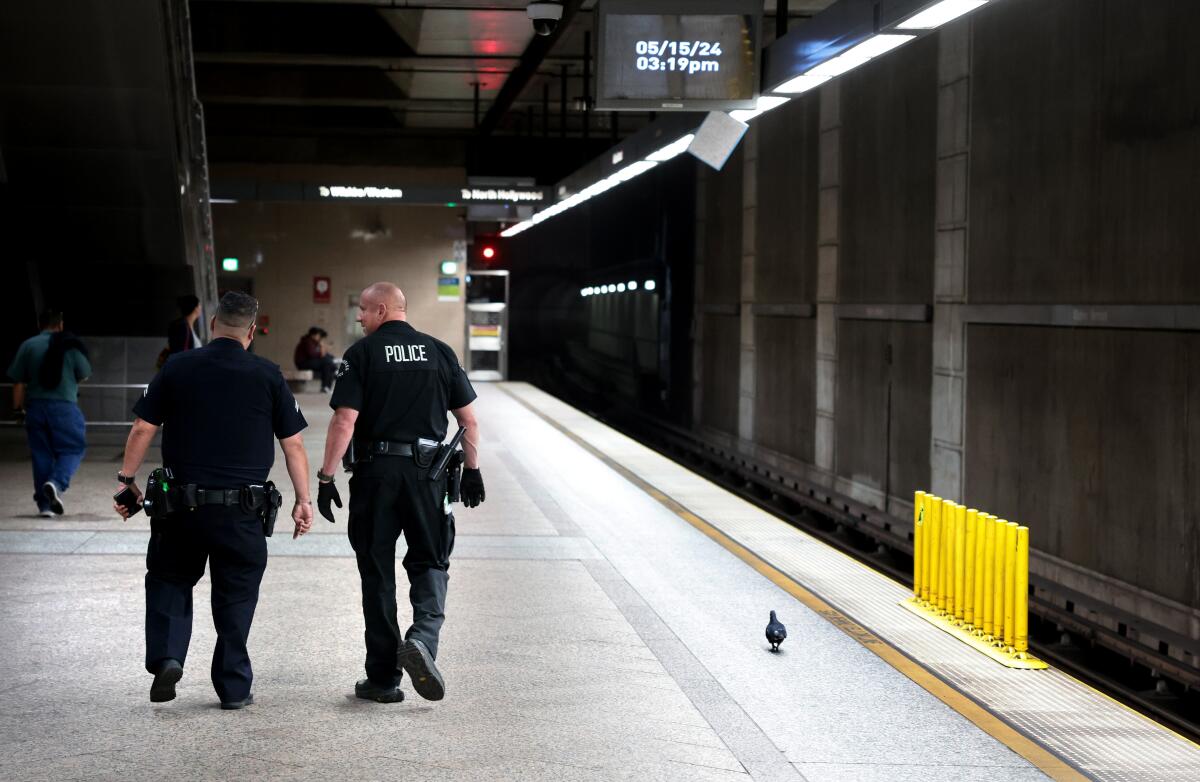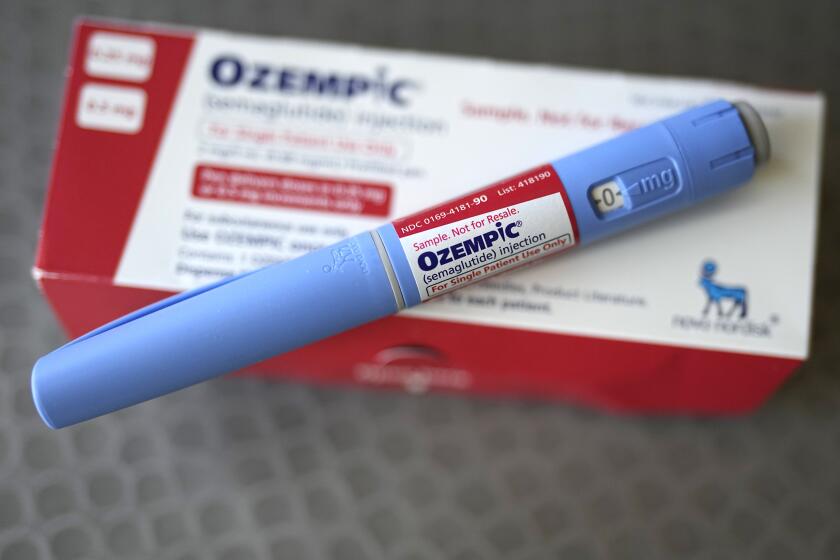How to make Metro’s subways and buses safer? Riders have ideas

- Share via
Good morning. I’m Kerry Cavanaugh, and it is Wednesday, May 22. Let’s look at the week so far in Opinion.
Los Angeles County’s public transit system is experiencing a crisis of confidence. There’s been a series of violent and deadly attacks on trains and buses, including the shocking killing of Juan Luis Gomez Ramirez, a teacher visiting from Mexico who was taking the bus back to his family when he was shot in the head. He was killed just hours after L.A. Mayor Karen Bass and Metro leaders announced a “surge” in law enforcement on the system, along with a directive that officers proactively walk through trains and buses.
Despite their reputation as residents of a region steeped in car culture, Los Angeles County voters have repeatedly agreed to tax themselves to expand the bus and rail system. But public support will dwindle if buses and trains do not feel safe. That threatens to send Metro into a doom spiral, with the system never gaining the ridership needed to help reduce traffic and pollution. The violence has shaken even the most steadfast transit backers, including L.A. Times’ letter writers who shared their critiques and ideas to turn things around.
“Making Metro safer isn’t rocket science,” writes Donald Flaherty Fajardo of Los Angeles, who offered a seven-point plan, which includes requiring police to actively patrol buses and trains and remove unruly passengers, turning up the lights and cleaning the stations, and requiring city leaders to ride Metro at least once a week.
“I often see people jumping over the ticket gates at the stations without paying, which helps create an atmosphere where there are no rules. It starts making me feel foolish for paying my own fare,” writes Doug Weiskopf of Burbank. “I rode the BART system in San Francisco recently, where there were employees checking that riders had paid fares before boarding. I also saw security guards who did not allow loitering or misbehavior at the stations.”
“Los Angeles should implement designated seating areas for seniors, women, disabled riders and children to enhance safety and comfort by reserving sections painted pink for these vulnerable groups,” writes Paulette Greenberg of Culver City.
“Perhaps it is time to return to a dedicated transit police department,” writes Judy Wilson of Pasadena.
“I will not take Metro until there is a large, dependable and accountable security force and a system that will not allow people to ride unless they pay,” writes Shirley Tatsuno of Alhambra. “Our ‘car-free’ 2028 Summer Olympics transportation system is in real jeopardy unless drastic changes are made quickly.”
And Robert Joseph Narlian of Escondido writes, tongue in cheek, about his “sublime solution” that doesn’t involve more police officers: “You simply have an armorer on each train and bus hand out a gun to every passenger who gets on and then collects the guns when they get off. Except for the children of course. They will get knives. And the driver is allowed to carry a flamethrower.”
Wait times go down. Patient satisfaction goes up. What’s the matter with letting apps and AI run the ER? A lot, actually. Hospitals have already incorporated algorithms into their workflow, making medicine more “technology- and test-dependent and less patient-centric,” writes Dr. Eric Snoey with the Alameda Health System-Highland Hospital in Oakland. “With AI primed to take on a substantial role in how doctors deliver care, we should remind ourselves: If we behave like machines, we certainly won’t be missed when machines replace us.”
California blew it on bail reform. Now Illinois is showing it works. The Land of Lincoln rolled out its no-money-bail program nearly a year ago, and the data show it is working well, writes The Times’ editorial board. There has not been an increase in arrests of people released pending trial, and defendants are generally showing up for their hearings. And there are real benefits to the change: “Billions of dollars in bail bond payments that were previously extracted from families, usually from those who could afford it the least, can be used for housing, food and other daily expenses.”
Enjoying this newsletter? Consider subscribing to the Los Angeles Times
Your support helps us deliver the news that matters most. Become a subscriber.
Whatever Big Oil wants, Big Oil gets. As long as it bankrolls Trump. Columnist Jackie Calmes laments that Trump’s “deal” offered to oil executives in exchange for their campaign contributions didn’t get more attention. “As has often been said about campaign finance, these days it’s not what’s illegal that’s the problem; it’s what’s legal. Even so, Trump’s unethical actions should shock. For more than one day.”
How do L.A.’s ethnic communities keep their identities while living with others? Just read the signs. Unlike other major American cities, L.A.’s racial and ethnic groups don’t huddle in enclaves; they are spread across the region and interspersed among each other, writes Annette M. Kim, a professor of urban planning and director of USC’s Spatial Analysis Lab. “And it’s not just that we happen to be next door to each other. We talk to each other. We found that signs on 18% of properties in L.A. contain more than one language or cultural expression. It’s not uncommon to see one sign featuring three or more languages.”
More from this week in opinion
From our columnists
- Jonah Goldberg: Trump and Biden agreed to debates. That’s a lot less important than it was made out to be
- Robin Abcarian: Israel’s Gaza war is horrific, but that doesn’t mean Hamas is innocent of sexual violence
- LZ Granderson: Whose lives matter to Texas’ governor?
From the Op-Ed desk
- Studio productions keep moving out of Los Angeles. We need to stop the bleeding
- No, the Israeli-Palestinian divide is not unbridgeable. Here’s how I know
- AI and privacy rules meant for Big Tech could hurt small businesses most
From the Editorial Board
- Texas Gov. Greg Abbott’s pardon of man who killed protester undermines trust in the justice system
- A felony conviction should not come with a life sentence on voting rights
- California can make climate polluters pay for the mess they have made of Earth
Letters to the Editor
- Opposing views on L.A. County’s ‘Jane Fonda Day’ and the Vietnam War
- Why standardized testing for 4-year-old students makes no sense
- Does divestment work, or is it just protesters trying to ‘do something’?
Stay in touch.
If you’ve made it this far, you’re the kind of reader who’d benefit from subscribing to our other newsletters and to The Times.
As always, you can share your feedback by emailing me at paul.thornton@latimes.com.
A cure for the common opinion
Get thought-provoking perspectives with our weekly newsletter.
You may occasionally receive promotional content from the Los Angeles Times.







